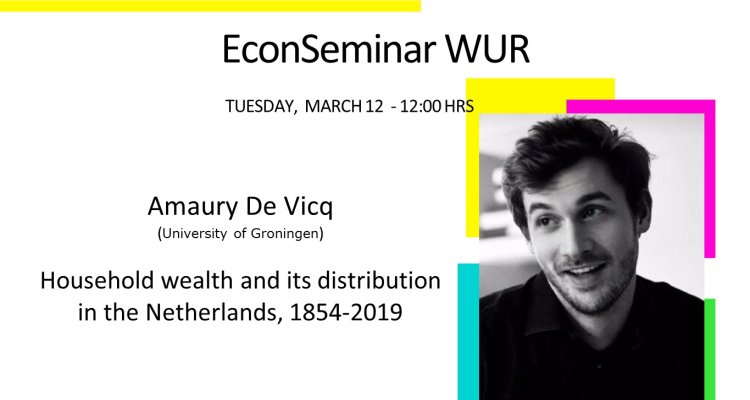
Seminar
Amaury De Vicq (University of Groningen):“Household Wealth and its distribution in the Netherlands, 1854-2019."
Tuesday March 12, Amaury De Vicq (University of Groningen) will give a seminar entitled “Household Wealth and its distribution in the Netherlands, 1854-2019."
The seminar will take place in room B0079 between 12:00-13:00.
Lunch will be provided.
Abstract:
We analyze the evolution of aggregate household wealth, its composition, and top wealth shares since the mid-19th century for the Netherlands, a country which played a significant role in economic history. The main forces at play are the size and variation of colonial wealth up until WWII, and the introduction of a –particularly strong– pension system thereafter. We show that the wealth-income ratio followed the familiar U-shaped pattern over the 20th century. The Netherlands, however, had the largest wealth-income ratio on record, growing since the mid-1850s, driven by industrialization and booming private foreign investments, to a peak of 900% around 1880. In contrast to other countries, the wealth-income ratio remained high up until 1929. To better understand these trends, we construct the first series on colonial wealth and show that colonial and other foreign investment account for most of the gap with other countries in the pre-WWII period. The initial post-war decline in the ratio is driven by rapid income growth. The increase in the ratio since the 1970s has been mainly driven by the uniquely large capital-funded pension system. In contrast with other major countries, housing plays only a secondary role in net wealth accumulation due to significant mortgage debt. Methodologically, we are the first to compare historical national accounts, estate multiplier, and wealth tax data approaches to construct aggregate wealth. We find that the estate multiplier is a good alternative to the historical national accounts benchmark, while the use of wealth tax data results in unrealistically low estimates.
We analyze the evolution of aggregate household wealth, its composition, and top wealth shares since the mid-19th century for the Netherlands, a country which played a significant role in economic history. The main forces at play are the size and variation of colonial wealth up until WWII, and the introduction of a –particularly strong– pension system thereafter. We show that the wealth-income ratio followed the familiar U-shaped pattern over the 20th century. The Netherlands, however, had the largest wealth-income ratio on record, growing since the mid-1850s, driven by industrialization and booming private foreign investments, to a peak of 900% around 1880. In contrast to other countries, the wealth-income ratio remained high up until 1929. To better understand these trends, we construct the first series on colonial wealth and show that colonial and other foreign investment account for most of the gap with other countries in the pre-WWII period. The initial post-war decline in the ratio is driven by rapid income growth. The increase in the ratio since the 1970s has been mainly driven by the uniquely large capital-funded pension system. In contrast with other major countries, housing plays only a secondary role in net wealth accumulation due to significant mortgage debt. Methodologically, we are the first to compare historical national accounts, estate multiplier, and wealth tax data approaches to construct aggregate wealth. We find that the estate multiplier is a good alternative to the historical national accounts benchmark, while the use of wealth tax data results in unrealistically low estimates.